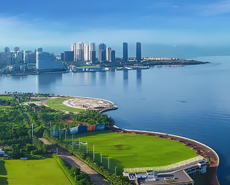
Low threshold hurts magnesia industry
----Interview with Zhao Quan
Vice-General Manager
Liaoning Donghe New Material Co., Ltd.
Vice-General Manager
Liaoning Donghe New Material Co., Ltd.
Founded in 1996, Liaoning Donghe New Material Co., Ltd. is a leading company engaging in comprehensive application of magnesite resources. It was granted the title of Provincial-Level Engineering Technology Research Center in 2014, the only one Demonstration Engineering Company for Comprehensive Application of Magnesite by MIIT in 2015 and the High-Tech Company in 2016. It was listed in New Three Board in 2016 with the security abbreviation of Donghe New Material and the stock code of 839792. Donghe New Material is now a company with complete industrial chain, strong competitiveness and vibrant development.
Asian Metal: Hello, Mr. Zhao! Please make a brief introduction to your company firstly.
Mr. Zhao: Founded in 1996, Donghe New Material is a leading company focusing on comprehensive application of magnesite resources. Its main products include caustic calcined magnesium oxide, fused magnesium oxide, monolithic refractory and refractory brick and it supplies services of design and manufacturing of refractories used in various kilns to steel mills. The company owns over 600 employees with total registered capitals of RMB133.53 million (USD18.97 million), covering over 130,000 square meters. It was granted the title of Provincial-Level Engineering Technology Research Center in 2014, the only one Demonstration Engineering Company for Comprehensive Application of Magnesite by MIIT in 2015 and the High-Tech Company in 2016. It was listed in New Three Board in 2016 with the security abbreviation of Donghe New Mateial and the stock code of 839792. Donghe New Material is now a company with complete industrial chain, strong competitiveness and vibrant development. Haicheng Donghe Taidi Metallurgical Furnace Material Co., Ltd. is a wholly-owned subsidiary of Donghe New Material.


Asian Metal: Would you mind to share with us the magnesia market condition over the past two years?
Mr. Zhao: The Chinese magnesite industry has undergone ups and downs in recent two years. Measures on environmental improvement and mining control make magnesite companies realize that they can't develop in future if they refuse to improve themselves, maintain green production and upgrade the industry to gain economics of scale.
China produced 23.45 million tons of refractories in 2018, up by 2.3% YOY. In particular, the output for shaped refractory products was 13.27 million tons, up by 2.33% YOY; that of unshaped refractory products was 9.64 million tons, up by 2.10% YOY. In 2018, China exported 6.35 million tons of refractory raw materials, down by 0.54% YOY. Due to soft demand yet large volumes of stocks, the Chinese refractory market sees unbalanced supply-demand now and prices decline accordingly. We expect that it would be hard for the market to improve in short term due to many unfavorable factors.


Asian Metal: What are major problems in current magnesia industry?
Mr. Zhao: These problems include constant supply shortage for high quality magnesite, overcapacity caused by redundant construction, lower export volume and export price, backward technology and equipment, great pressure resulted from strict requirements on energy reduction and pollution control. In a word, there is an urgent need to upgrade the magnesite industry.















